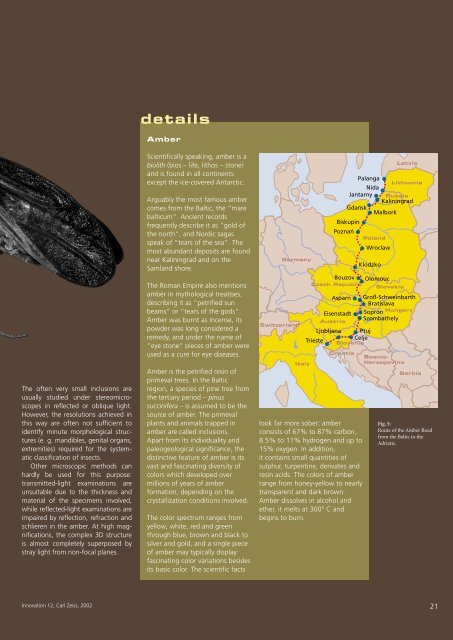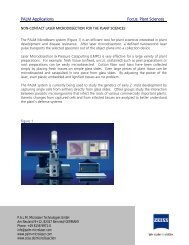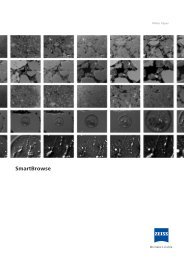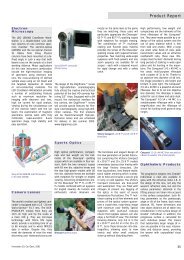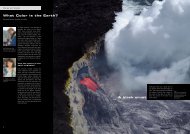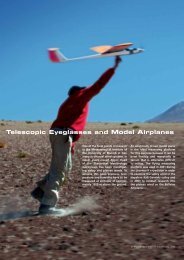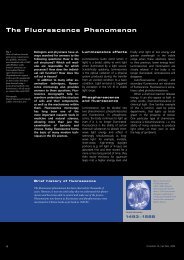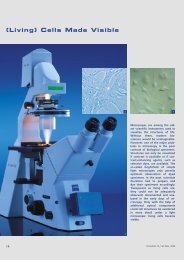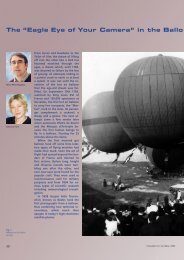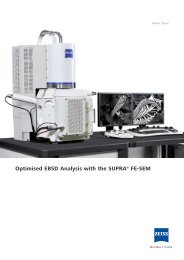Fascinating Amber - Carl Zeiss, Inc.
Fascinating Amber - Carl Zeiss, Inc.
Fascinating Amber - Carl Zeiss, Inc.
You also want an ePaper? Increase the reach of your titles
YUMPU automatically turns print PDFs into web optimized ePapers that Google loves.
details<br />
<strong>Amber</strong><br />
The often very small inclusions are<br />
usually studied under stereomicroscopes<br />
in reflected or oblique light.<br />
However, the resolutions achieved in<br />
this way are often not sufficient to<br />
identify minute morphological structures<br />
(e. g. mandibles, genital organs,<br />
extremities) required for the systematic<br />
classification of insects.<br />
Other microscopic methods can<br />
hardly be used for this purpose:<br />
transmitted-light examinations are<br />
unsuitable due to the thickness and<br />
material of the specimens involved,<br />
while reflected-light examinations are<br />
impaired by reflection, refraction and<br />
schlieren in the amber. At high magnifications,<br />
the complex 3D structure<br />
is almost completely superposed by<br />
stray light from non-focal planes.<br />
Scientifically speaking, amber is a<br />
biolith (bios – life, lithos – stone)<br />
and is found in all continents<br />
except the ice-covered Antarctic.<br />
Arguably the most famous amber<br />
comes from the Baltic, the “mare<br />
balticum“. Ancient records<br />
frequently describe it as “gold of<br />
the north“, and Nordic sagas<br />
speak of “tears of the sea“. The<br />
most abundant deposits are found<br />
near Kaliningrad and on the<br />
Samland shore.<br />
The Roman Empire also mentions<br />
amber in mythological treatises,<br />
describing it as “petrified sun<br />
beams“ or “tears of the gods“.<br />
<strong>Amber</strong> was burnt as incense, its<br />
powder was long considered a<br />
remedy, and under the name of<br />
“eye stone“ pieces of amber were<br />
used as a cure for eye diseases.<br />
<strong>Amber</strong> is the petrified resin of<br />
primeval trees. In the Baltic<br />
region, a species of pine tree from<br />
the tertiary period – pinus<br />
succinifera – is assumed to be the<br />
source of amber. The primeval<br />
plants and animals trapped in<br />
amber are called inclusions.<br />
Apart from its individuality and<br />
paleogeological significance, the<br />
distinctive feature of amber is its<br />
vast and fascinating diversity of<br />
colors which developed over<br />
millions of years of amber<br />
formation, depending on the<br />
crystallization conditions involved.<br />
The color spectrum ranges from<br />
yellow, white, red and green<br />
through blue, brown and black to<br />
silver and gold, and a single piece<br />
of amber may typically display<br />
fascinating color variations besides<br />
its basic color. The scientific facts<br />
Germany<br />
Switzerland<br />
Italy<br />
Poland<br />
Wroclaw<br />
Bouzov Olomouc<br />
Czech Republic<br />
Slovakia<br />
Eisenstadt<br />
Austria<br />
Ljubljana Ptuj<br />
Trieste<br />
Celje<br />
Slovenia<br />
Croatia<br />
Palanga<br />
Nida<br />
Jantarny<br />
Gdańsk<br />
Biskupin<br />
Poznań<br />
Asparn<br />
look far more sober: amber<br />
consists of 67% to 87% carbon,<br />
8.5% to 11% hydrogen and up to<br />
15% oxygen. In addition,<br />
it contains small quantities of<br />
sulphur, turpentine, derivates and<br />
resin acids. The colors of amber<br />
range from honey-yellow to nearly<br />
transparent and dark brown.<br />
<strong>Amber</strong> dissolves in alcohol and<br />
ether, it melts at 300° C and<br />
begins to burn.<br />
Klodzko<br />
Latvia<br />
Lithuania<br />
Russia<br />
Kaliningrad<br />
Malbork<br />
Groß-Schweinbarth<br />
Bratislava<br />
Sopron Hungary<br />
Szombathely<br />
Bosnia-<br />
Herzegovina<br />
Serbia<br />
Fig. 5:<br />
Route of the <strong>Amber</strong> Road<br />
from the Baltic to the<br />
Adriatic.<br />
Innovation 12, <strong>Carl</strong> <strong>Zeiss</strong>, 2002<br />
21


